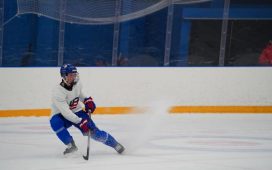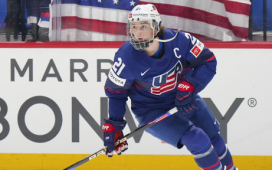It was the spring of 1986 and there I was at the Laurentian University athletic field in Sudbury, Ont., with a camera around my neck and a notepad in my hand, covering the northern Ontario high school track and field championship, when I saw this gangly, awkward 15-year-old kid crushing his opponents in the 800-metre race. The kid’s name was Brian Savage and, being a sports guy at the local newspaper, I already knew who he was. He was an outstanding golfer and his father taught math at my high school. Never taught me, though, because he was an AP teacher and those kids were on another planet from your trusty correspondent when it came to numbers and formulas.
Savage ended up running the 800 in 2:02.5 that day, a mark that still stands as the record for midget boys in northern Ontario. When I approached him to talk after the race, he told me that he had grabbed one of his cleats and another belonging to his older brother, whose foot was three sizes bigger. I remember taking a picture of him holding up the two cleats and writing a story about this kid who smashed a record with two different pairs of shoes. The thing was, Brian Savage didn’t even play hockey at the time. He had given up the sport to commit to golf and high school athletics and basically skipped three years of the most important development years of his life.
The relationship that began that day with Savage, who went on to play for Canada’s Olympic team and enjoyed an 11-year NHL career, still endures and is one of many I made in two wonderful years working in my hometown as the sports editor of a twice-weekly paper called Northern Life. I recount this story because the edition that came off the presses today is the last print edition of a newspaper that published for 47 years, competed hammer-and-tong with – and often triumphed over – the daily Sudbury Star and provided me with some of my most enduring lessons in this business and in hockey. What a gut punch.
It will still be published in digital form, but the company that owned it was sold to a media conglomerate in Sault Ste. Marie and, of course, some good and hardworking people lost their jobs. That’s sad. Especially at a uncertain time like this. My heart aches for them. I can only hope their experience at that wonderful little paper and in that beautiful town were as positive as mine.
I was hired to create a sports section for the paper in 1986, after one year of working at the Timmins Daily Press, which was my first job in the business after university. It was a one-person sports department that later became two and working there provided me with the opportunity to cover a major junior hockey team. The only thing was that, at the time, the Sudbury Wolves were truly terrible in every way. They might have been the most dysfunctional and least successful junior hockey team in Canada at the time. Each time a coach was fired, his picture would go up on the wall at the Frood Hotel, a local watering hole, and by the mid-80s the place was plastered with headshots. But that team was also fertile ground for a young and enterprising reporter. The stories were plentiful and bountiful.
One of the players I remember best from that team was Mario Chitaroni, a 5-foot-8, 175-pound fire hydrant who was nicknamed ‘Tiger’ for his off-the-charts competitiveness. He never backed down from anyone and never met a goaltender he didn’t want to run over. He scored a mind-boggling 54 goals in 63 games for the 1986-87 edition of the Wolves, mind-boggling because the Wolves were the worst team in the league and Chitaroni played the last two months of the season with a broken wrist. He scored 102 points that season, one more than Keith Gretzky and two more than Adam Graves and, despite being a star in a tire fire of an organization, never asked for a trade. Chitaroni went on to play 20 seasons in Europe and represented Italy 13 times in the World Championship and twice in the Olympics. In 2001, he led the Worlds with 60 penalty minutes in five games.
That was the same year another local kid, Scott McCrory, led the OHL with 150 points playing for the Oshawa Generals, then scored 37 points in 24 playoff games, leading the Generals to two seven-game triumphs over the North Bay Centennials, the first in a Super Series to decide which team would host the Memorial Cup and again in the OHL final. McCrory’s father, Gerry, basically ran minor hockey in Sudbury for years and now has an arena named after him.
One of the great things about bad junior teams is there is a constantly changing cast of characters, some of whom are running out of chances. Late that season, the Wolves picked up a veteran goalie by the name of Dan Gatenby, who wore the rather odd No. 13 for his first couple of games with the team. When I asked him why, he responded completely deadpan, “That’s how old my girlfriend is.” Times were much, much different then.
After that season, on my way to the OHL draft in Toronto where the Wolves were taking their newest savior, John Uniac, with the first overall pick, I totalled my Hyundai Pony on Highway 400 when I hit a log in the middle of the road, landed in the opposite lane and sideswiped an oncoming car. I needed a ride home and jumped in with Doug Bonhomme, a regional scout with the league’s Central Scouting Bureau who grew up on an adjacent street and with whose brother I played playground hockey. Doug, who also worked with my sister at the Workers’ Compensation Board, would later have a daughter named Tessa. You’ve probably heard of her.
But it was the next season, my last in Sudbury, that would be so pivotal to my future, particularly pertaining to The Hockey News. The first incident came early in the season when Marc LaForge, who went on to amass more than 3,000 PIM in professional hockey, went on a one-man rampage against the Guelph Platers late in a game. As players were tied up in a line brawl, LaForge went from altercation to altercation sucker punching opponents. He was banned for life from the league by commissioner David Branch and when I asked LaForge several days later what he would tell young players who emulated him he said, “I’d probably tell them to go the Betty Ford Clinic.” I just happened to be hanging over the boards with my camera and got pictures of the incident, which I sold to THN and forged a relationship with the staff there.
The other came in the form of Wolves coach John Wallin, who had come to Sudbury from Kent State University. In a piece that appeared in THN, he told about how he had served in Vietnam and some of the horrors he witnessed there. The only problem is the entire thing was a lie. I didn’t write the story, but I did take pictures for it that were used by THN and helped with some reporting in the aftermath. By the time I came to Toronto for my interview with THN in the summer of 1988, I already knew the legendary editor-in-chief Bob McKenzie. The first thing he said after looking at my portfolio was, “Looks like you work pretty hard there.”
Yeah, I did. And I would not trade a minute of it for anything. For my work at Northern Life, and I suppose after at THN and The Toronto Star, I was lucky enough to be inducted into the media wing of the Sudbury Sports Hall of Fame in 2016. It remains one of the biggest honors of my career and life. Meanwhile, I still have a T-shirt commemorating the 25th anniversary of the Northern Life. I think I’ll go and put it on.
Want more in-depth features and analysis? Subscribe to The Hockey News magazine.








